1993 British Grand Prix race report - Hill makes a point
Xenophobia, team tactics and a very small crowd; the first Mansell-less British GP since 1981 broke some new ground, but the end result was familiar
In the end, all the pre-race hype about team tactics became academic, but while it lasted the long-anticipated showdown between Williams-Renault team’s Damon Hill and Alain Prost was really quite a humdinger.
In the week leading up to Britain’s premier race you couldn’t pick up a tabloid newspaper without it exhorting Frank Williams to ‘give Damon a chance’ as they sought to create a new Nigel Mansell. In the wake of the dutiful performance he had turned in riding shotgun to Prost the previous week in Magny-Cours, Hill’s more xenophobic supporters demanded of Williams that their hero be given the chance to express himself fully, without any team orders being imposed. Whether, ultimately, they were depends upon whom one spoke to at Williams. Or, indeed, on when you spoke to Frank himself.

The Williams pari and Ayrton Senna fight for the lead of the race
Motorsport Images
While refusing to comment about tactics on Saturday, when Prost had so narrowly pipped Hill to score his eighth pole out of nine races, Frank had conceded that the championship struggle had to have priority. In other words, at that stage he was prepared to favour Prost. Later that evening, however, another team member inadvertently disclosed that Hill would be allowed to race without restriction.
His raceday performance certainly inclined one to the latter view. It wasn’t so much that Prost made a bad start; just that Hill and Senna’s were better. As Damon yet again snatched the lead, the Brazilian boiled through to grab second in a McLaren that had been a disappointing handful not only throughout qualifying, but also during that morning’s warm-up. In the cockpit, Senna was prepared to gamble. Overriding race engineer Giorgio Ascanelli’s advice, he had the absolute minimum amount of fuel aboard, and though the MP4/8 still looked twitchy, he was exploiting its weight advantage over Prost’s Elf-heavy Williams to the maximum. At Stowe Prost looked down the inside on lap two, but the expected response was a sharp chop. At Bridge Senna again swooped back on to the racing line, as Schumacher sat right behind them both just awaiting the opportunity to exploit mistakes by either.
For Senna it was, of course, a bit of window dressing. He knew full well that Prost’s superior equipment would tell, even though for this race he finally had the Ford Series V11 HB that he has coveted all season, but the interesting thing was that despite a clear track Hill was not storming away to the extent one might have expected from a man presented with such a Heaven-sent opportunity. By lap five he had 4.8s on Senna, but when Prost finally found a way by the wide McLaren at Stowe two laps later, after some gripping side-by-side motoring through Copse and down to Chapel, the gap was still only 8.1s. What followed then certainly did not smack of team orders. The gloves were off, and the two Williams pilots were free to fight. Whether that freedom would break with established 1993 tradition and embrace the final 10 laps as well would never become clear, however.

Senna ahead of Prost through Copse
Motorsport Images
What was clear, though, was that Bernard Dudot’s pre-event belief that Benetton and McLaren would pose a stronger threat was unfounded. “The Williams is a very good car aerodynamically,” he had said, “but I believe that the Benetton has a very good suspension system that has made it very fast round this circuit in testing.” Silverstone has now metamorphosed into one of the trickier circuits on which to set up a car, with its quick corners requiring minimal wing, but the slow Priory/Luffield complex putting downforce at a premium. On the day, the Williams’s aerodynamic efficiency gave them a trump card, and also highlighted shortcomings in the McLaren. “Look at the straightline speeds; we’ve got our wings tuned right down and we’re still way down the list,” Michael Andretti had rued after the morning warm-up. In the race Senna had opted for greater down force, but that was still not the answer. Once Prost had gone by it took Schumacher only until lap 10 to displace the McLaren, with a neat move into Stowe, and thereafter Senna settled back to his own pace. It would be sufficient to keep him ahead of Martin Brundle’s well-driven Ligier, but not enough to aspire to anything better than fourth without somebody else meeting misfortune.
By lap 20 Hill was still controlling the race, in celebration of the anniversary of his F1 debut, but by then the gap was 6.8s. He had set a flurry of fastest laps in the early going, but then Prost had come back with seven of his own as they kept one another honest. If this was a fix, it was a very convincing one.
They kept at it through their tyre stops, and unlike Magny-Cours there was nothing to disrupt Hill’s rhythm this time. Prost came in first, on lap 29, and was stationary for 8.02s. Hill pitted a lap later and his standing time occupied only 7.61s, although traffic then reduced his overall advantage to only 3.3s by the time they had settled down again. Just as in Magny-Cours, Prost had pushed very hard as his teammate sat in the pits, and his 31st lap lowered the fastest time yet again. Three laps later he lopped another half second off his time and there were the makings of the best race of the year as they circulated only 2.1s apart as the 35-lap mark was reached. A lap later, however, help came to Prost from an unexpected source: the Safety Car.
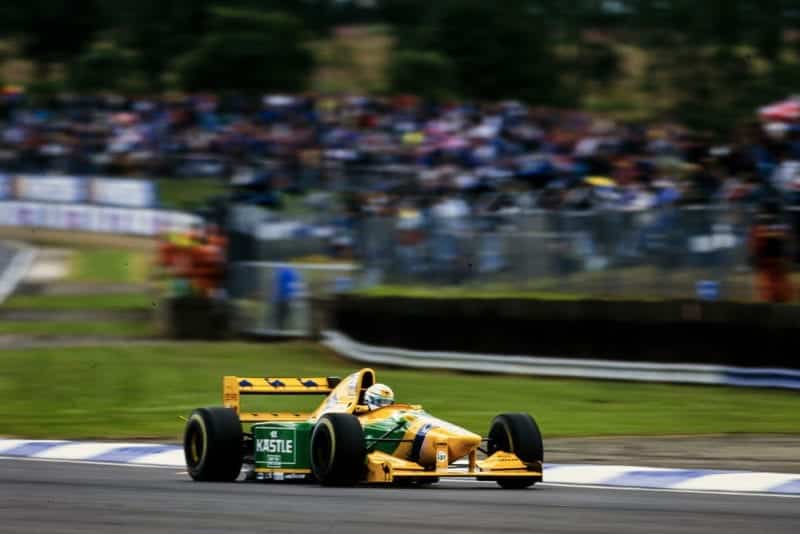
Riccardo Patrese in the Benetton
Motorsport Images
Luca Badoer had been fighting his way along in a lapped and distant 17th place on lap 33, when the unlovely Lola-Ferrari glided to a silent halt on the grass almost opposite the pits. The earth lead had broken, and after the T93/30 had sat there for three laps Roland Bruynseraede elected to deploy the safety vehicle while the car was removed. As is usually the case, there was criticism and talk of the race being ‘fixed’, but it was such a good dice that it was hard to believe that officialdom might have been tempted to enliven things further. Indeed, Bernie Ecclestone was said to be livid, particularly as it would seem so contrived. In reality, it was just Hill’s tough luck. For three laps the field cruised round, bunching up. For Hill it was added pressure just when he could have done without it; for Schumacher a chance to slash what had been a 25s deficit to only five as only Blundell and Warwick (fighting tooth and nail for eighth place) and a twice lapped Boutsen sat between his Benetton and the Williams duo. Further back, Senna was trapped behind a massive fight for 10th which almost had a bigger crowd than there was in the grandstands and comprised Lehto, Alliot (who ran through non-stop in his Larrousse), Fittipaldi (ditto, because Minardi is so financially troubled), Barrichello, Alesi and Zanardi. That allowed Brundle to close back up on Senna, while Patrese and Herbert, sixth and seventh from the start, had their chance to challenge the Ligier.
While they ran behind former F3 racer Mark Goddard in the Escort Cosworth Safety Car, the Williams FW15Cs closed to within two tenths of a second of each other, but when the race went green again on lap 39 Hill burst away once more. By lap 40 he had stretched the gap to seven tenths, and the race’s fastest lap on the 41st opened that to 1.35s. In doing so Hill had noticeably been right on the ragged edge, particularly at Copse that final lap, while Prost was his usual smooth, unruffled self, lust waiting. If this one had gone down to the wire it would have been as fascinating as Mansell v Piquet in 1987, a battle of contrasts and wills. “It was a hard race,” Prost admitted afterwards. “I just wanted to go until the end behind Damon and just wait for the right opportunity, but I don’t think I would have won it as it would have been difficult to get by him.” Perhaps he was being charitable; perhaps not. Like Moss and Fangio at Aintree in 1955, we will never know for sure. Coming through Club on lap 42 Hill felt the first shiver of protest from deep within his Renault V10. Through Bridge, as he slowed dramatically and Prost slid by, it began to plume smoke and flame. By Priory the fairy tale was over. The crowd, which had cheered as it saw the second Williams falter, groaned as it realised which one it was.
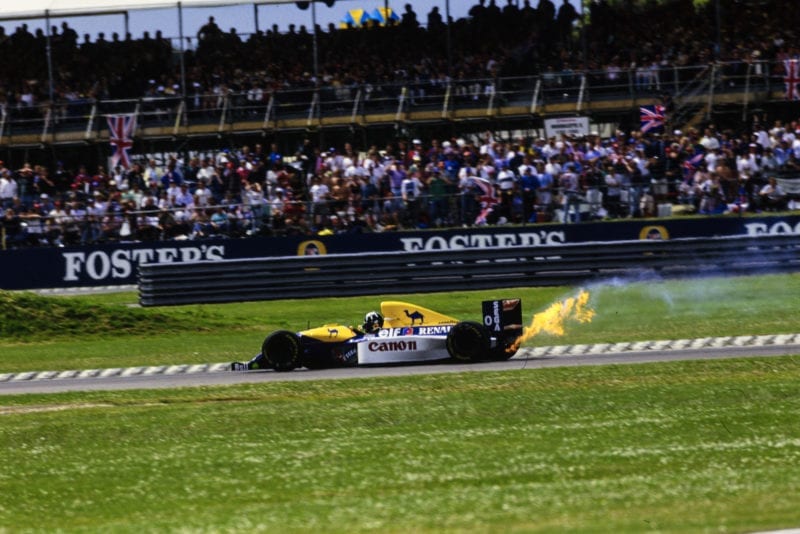
Hill retires from his home race
Motorsport Images
“The engine just caught fire,” said a stunned Hill, whose father’s efforts to win his home race had similarly met with frustration. He sat disconsolately on the Armco for minutes, before quietly walking back to the pits. “I feel a little bit of disbelief, as I’ve completed countless endurance runs and miles of testing round here. This is only the second time I’ve had an engine failure and both times it’s cost me a race. I was doing what I had planned to do and everything was going OK. I could have done without Alain closing the gap a little bit, but given a clear track it would have been difficult for him to get past.
“I don’t know exactly what happened, but it’s so frustrating. I feel totally empty. It is no consolation to have done everything right and not get a result. It is a big nothing.”
“We have to wait to get the engine back to the factory to see exactly what happened,” said Dudot, “but for the moment we can say it was a failure with no warning at all. We think the problem was most likely a broken cam follower.”
Not a part that could suffer from user abuse; just pure bad luck . . . Really, he had deserved to win. Hill’s demise apparently left the race to Prost as the crowd began, tifosi-like, to drift away after its favourite succumbed. The excitement wasn’t over, however. Schumacher was making the most of his second chance. “In the opening laps Senna held him up and lost him the chance to run with the Williamses,” suggested Tom Walkinshaw. Now the German got his head down and began a series of quick laps that steadily whittled the gap down to Prost. From 7.9s on lap 45 it had shrunk to 4.1s five laps later, and by his own admission Prost was taking it a kale easy after Hill’s failure, just in case. As the potential pressure increased he speeded up, though, and steadily the gap grew again. “I thought Alain might have a problem,” said Schumacher, “but once I’d closed up he was able to push a little bit harder and I realised that there was no point to keep on the very edge.” If the lead was thus settled, there was plenty of interest further down the field. Senna, promoted to a lucky third, was clearly having to hold back in a portent of what was to come, for his fuel situation was not encouraging. Behind him Brundle, Patrese and Herbert continued to fight, with Johnny outfoxing the Italian round the outside at Luffield on lap 42 when Brundle locked a wheel while trying to find his way by Alesi.
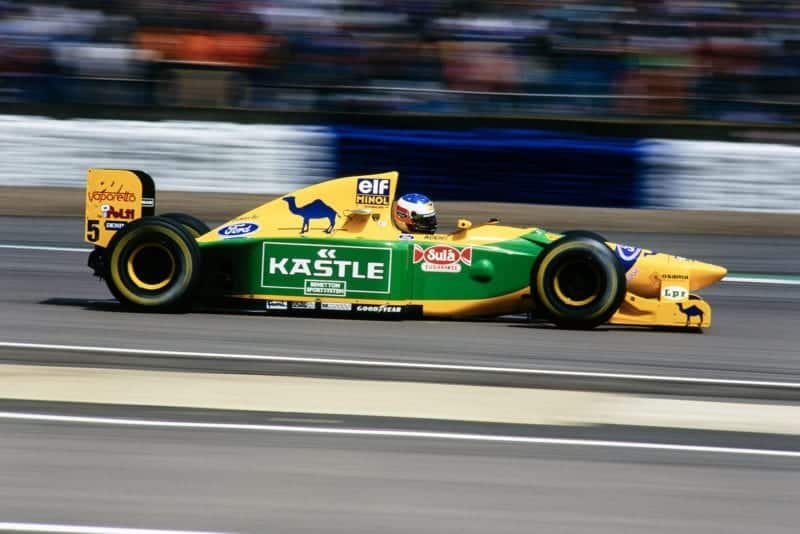
Michael Schumacher would finish second, his sixth podium finish of the season
Motorsport Images
Sadly, the Lotus driver then came across Alliot, who steadfastly refused to move out of the way even though his Larrousse had lost its edge as his tyres had worn. “One time I was about to go down the inside of him at Bridge, and then I thought twice about it. Just as well I did; he chopped right across! If I’d been there, we’d both have gone off.” For Lotus, a finish was essential, after qualifying had finally proved that post Magny-Cours changes to the 107B’s weight distribution and active suspension had at last restored much of its pre-season testing poise. As Herbert momentarily faltered, Patrese got a run at him and was able to reclaim fifth place on lap 46, but the battle did not abate. Brundle was not around to see its conclusion, though. With 10 laps to go his Ligier began losing gears fast, and he and Patrese were side-by-side past the pits and through Copse as they began lap 52. A lap later another problematic shift saw Riccardo towing right on to the blue car’s tail as they came through Woodcote, and as the Benetton edged to the outside Herbert dived towards a gap down the inside only to find Patrese cutting rudely back across. They missed each other, but not by much. Brundle lost his battle a lap later as his 1S39 rolled to a halt, and thereafter it was a straight fight between the Benetton and the Lotus.
The former was quicker down the straights, the latter better through Stowe, Club and Bridge. In the final analysis, straightline speed won the day, but they finished less than a second apart. What became sixth place had been the subject of an equally engrossing tussle between Warwick, in an improving active Footwork, and Blundell in the second Ligier. The latter had counted himself mighty lucky in the rain on Friday afternoon to escape injury after spinning at Abbey and then watching Senna and Andretti arrive side-by-side just as he was preparing to decamp. The two McLarens separated just in time to go either side of the stricken Ligier, but it had been uncomfortably close . . .
Both had fought and conquered the Ferraris of Alesi and Berger in the early laps, and when Warwick lost five seconds in his pit stop Mark moved ahead into eighth place. He held it until a spin at Priory filled the sidepods with stones and spoiled his tyres, and though he recovered to beat Lehto for seventh by the flag, he was no longer in a position to challenge the Footwork for the final point. The plight of the Saubers and the Ferraris highlighted the effect of the rules governing testing, which restrict teams to circuits within their own country. Neither team had any kind of set-up for Silverstone, and it showed as they struggled throughout qualifying. Where Sauber made a modicum of progress generating better tyre temperatures during the race, however, the Ferraris looked hopeless. After an early brush with Suzuki, Berger pitted twice to report serious handling imbalance, having already been doomed to run the spare F93A after his intended race car developed an engine problem. As he retired, Alesi soldiered on, damned by sluggish handling and a weak engine, and his misery was compounded by a broken air gun which created further delay during his tyre stop. True to form, however, this racer never gave up, fighting tooth and nail with Alliot, Fittipaldi, Barrichello and Zanardi for what would finally be ninth place. “Not one problem,” he grimaced, “but several.” Jean Todt summed the plight of the Prancing Horse up best, when he commented: “In this sport there are no miracles, and after what happened in Magny-Cours we should not have expected one.” Nevertheless, a miracle is precisely what Ferrari needs.
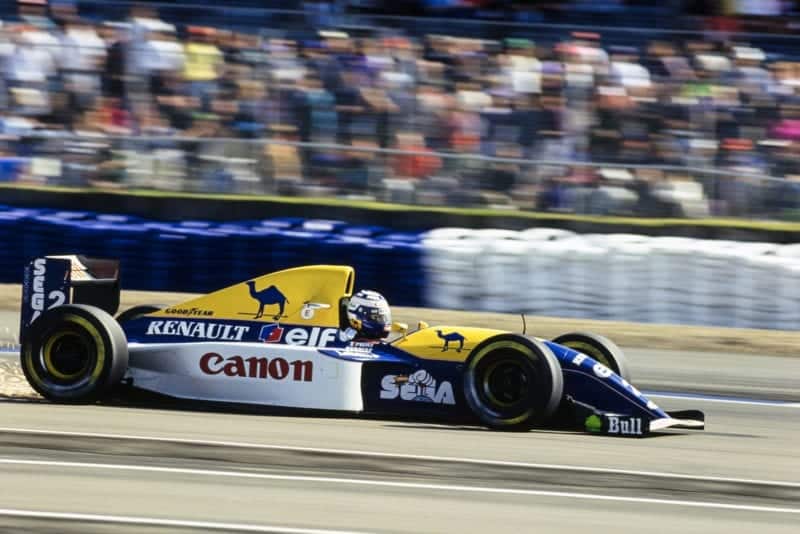
Prost on the way to his sixth win of the season
Motorsport Images
Alesi’s aggression taught Barrichello and Fittipaldi a few new lessons as they raced wheel-to-wheel, but like Herbert, Rubens found his rivals’ straightline speed insuperable and stayed behind the Minardi.
Zanardi spun at Bridge on lap 42 when failure of a front actuator on his Lotus upset the active suspension settings, and the group was whittled down further when Fittipaldi finally succumbed to loss of gears. Budgetary restraints had obliged the Faenza team to extend the life of some components, with unfortunate effect.
The final twist was reserved for McLaren. Fate had already struck Michael Andretti on the first lap when he ran wide at Copse trying to go outside Blundell and Berger and spun into retirement. Now it struck Senna on the last as he apparently paid the price for his gamble on fuel by running out. “It wasn’t his fault, though,” confirmed a team member. “The computer software was incorrectly programmed by a third party, and was projecting two litres left in the tank by the finish . . . ” It was, Ron Dennis admitted, a weekend of mistakes for McLaren. As Patrese thus inherited third and Herbert fourth, Prost had already swept home to increase his record tally of victories to 50, double that of the man whose driving style his so often mirrors.
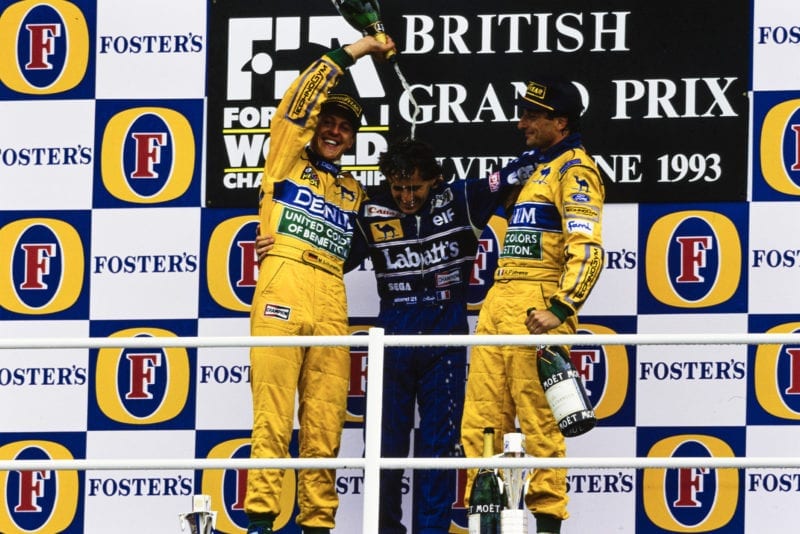
Prost is doused in champagne after winning the race
Motorsport Images
He would have preferred to win from the front, and he was honest enough to suggest that he might not have triumphed had his team-mate continued. “I would have liked to win my 50th in a different ambience,” he said, referring to the xenophobia that was so thankfully a feeble image of what we had to endure in 1992. “For sure the people here are very disappointed and I am very sorry for them and very sorry for Damon.” Nevertheless, 10 points were 10 points, but as what was left of the meagre crowd left Silverstone and the surrounding roads became clear again at an unusually early hour, thoughts turned to the FISA World Motor Sport Council meeting that followed at the end of the week, and in which the thorny subject of legality and fuel samples would finally be debated once and for all. There was little comfort for Senna at Silverstone, but if points were to be taken away from ‘illegal teams’ for the Canadian, French and British races, he alone of the front runners stood to lose the least. D J T
